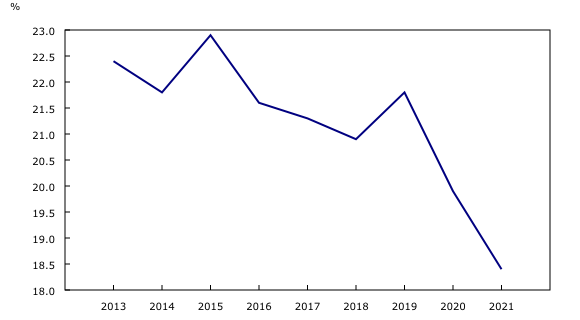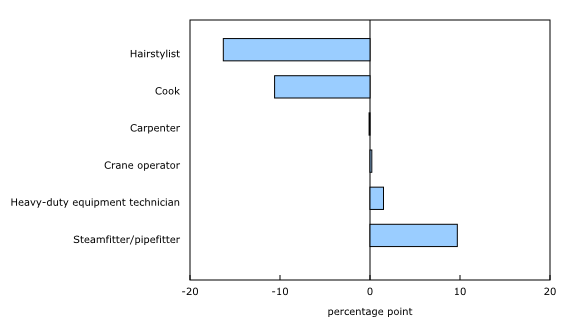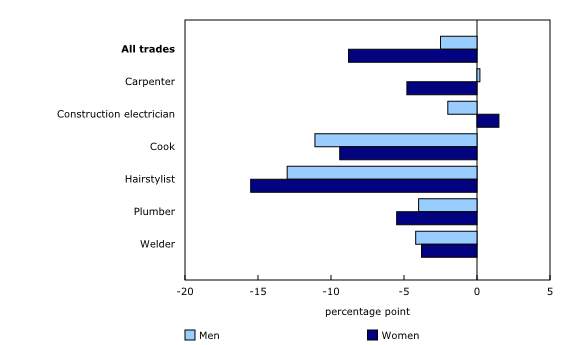Pathways indicators for registered apprentices in Canada, 2021
Released: 2023-08-28
The COVID-19 pandemic had a significant impact on the lives of many Canadians, including apprentices. The closure of numerous worksites and educational institutions disrupted on-the-job hours and technical training, making it challenging to accumulate credits toward certification. As a result, many apprentices faced challenges completing their programs on time.
Before the pandemic, 21.8% of apprentices completed their programs within the program duration. For those who finished their apprenticeships in 2021, this measure dropped to 18.4%, underscoring the significant impact the pandemic has had on certifications in the trades.
Certification rates drop for hairstylists and cooks but increase or remain stable for construction trades
In 2021, among the 25 selected Red Seal trades for which results are available, hairstylists (-16.3 percentage points) and cooks (-10.6 percentage points) experienced the most significant decline in the percentage of apprentices who received their certificates (certification rates) within the program duration. This decline can be attributed to the disproportionate impact of pandemic restrictions on specific industries. Despite the overall recovery of employment in 2021, certain industries, such as full-service restaurants and limited-service eating places (-19.4%) and personal care services (-21.6%), continued to have below pre-pandemic levels of employment. Furthermore, the two-year program duration for hairstylists and cooks is shorter compared with the typical four-year duration for other trades. As a result, apprentices aiming for certification by the end of their program duration in 2021 had to complete most of their training during the strictest pandemic restrictions.
By contrast, construction was designated as an essential sector and exempted from various public health measures in many provinces and territories, leading to increased or relatively stable certification rates in a few construction-related trades. These trades include steamfitters/pipefitters (+9.7 percentage points), heavy-duty equipment technicians (+1.5 percentage points), roofers (+0.4 percentage points), crane operators (+0.2 percentage points), and carpenters (-0.1 percentage points).
Because of the higher concentrations of female apprentices in trades that were more affected by the pandemic (e.g., hairstylists and cooks), the overall certification rates for female apprentices declined more than those of male apprentices in 2021.
However, for some trades, certification rates for female apprentices saw smaller declines or even an increase compared with those of their male counterparts. For example, certification rates for male cooks decreased by 11.1 percentage points, compared with 9.4 percentage points for female cooks. Similarly, the certification rate of female construction electricians had a small increase (+1.5 percentage points), whereas that of their male counterparts decreased (-2.0 percentage points).
In many trades, fewer apprentices certified or discontinued their training by the end of their program duration in 2021 compared with previous cohorts, and more apprentices were continuing their training. Whether this increased number of continuing apprentices is made up of those finishing their training with certificates or just postponing their discontinuation remains an important question to explore as more data become available.
Note to readers
Context
This release includes data from the 2021 Registered Apprenticeship Information System (RAIS) as a part of the Education and Labour Market Longitudinal Platform. Apprenticeship pathway data include information on certification, continuation and discontinuation rates at 1.0, 1.5 and 2.0 times the program duration, corresponding to four, six and eight years after registration for most programs. For more information on the concepts and the methodology used in this study, consult "Pathways indicators for registered apprentices in Canada, 2021."
Data, definitions and concepts
Apprenticeship pathway indicators were derived for all trades at the aggregate level and for selected trades at disaggregate levels, including the 25 Red Seal trades and 5 non-Red Seal trades that account for most apprentices from 2008 to 2021. Four non-Red Seal trades—child and youth worker, developmental services worker, early childhood educator, and educational assistant—are considered designated trades with apprenticeship programs only in Ontario.
Certification: The requirements for granting a certificate vary by province or territory in Canada. In most instances, apprentices are issued a certificate when they have completed requirements such as supervised on-the-job training, technical training and passing one or more examinations. Most trade qualifiers, meanwhile, become certified once they pass an examination.
Discontinuation: The proportion of apprentices who discontinued a given apprenticeship program after their registration date.
Continuation: The proportion of apprentices who are continuing a given apprenticeship program at the end of the reporting year.
Cohort: The group of apprentices who finished their program duration by the end of a given calendar year. The most common program duration is four years; however, it varies from one to five years across provinces and territories and trades. As a result, a cohort is a group of apprentices who start their training in different years, depending on the program duration. For example, the 2021 cohort is composed of apprentices who started a one-year program in 2020, a two-year program in 2019, a three-year program in 2018, a four-year program in 2017 and a five-year program in 2016.
Designated trades: Trades for which apprenticeship training and trade qualifications are available in Canada. These trades are governed by provincial and territorial jurisdictions that determine the trades for which apprenticeship training is made available and certificates are granted. Provinces and territories also determine which designated trades require certification to work unsupervised in the trade. Data from the RAIS include only trades designated in at least one province or territory.
Compulsory trades: Trades where workers are required to undertake or complete an apprenticeship program to be employed in the trade. Provinces and territories determine the compulsory or non-compulsory status of designated trades. As such, the compulsory or non-compulsory status of a designated trade varies across provinces and territories.
Registered apprentices: Individuals in a supervised work training program in a designated trade within their provincial or territorial jurisdiction. To complete the training, the apprentice must be registered with the appropriate governing body, usually a ministry of education, ministry of labour or trade-specific industry governing body.
Predominately male and female trades: Trade programs in which one sex accounts for at least 80% of all registered apprentices.
Red Seal and non-Red Seal programs: The Red Seal program sets common standards to assess the skills of tradespeople across Canada. Journeypersons who meet the Red Seal standards through examination receive a Red Seal endorsement on their provincial or territorial trade certificates. There are 54 trades at the national level for which common Red Seal standards are currently available. Non-Red Seal trades, by contrast, do not have interprovincial standards. Many non-Red Seal trades do not have an examination requirement to work in the trade.
Products
The research paper "Post-migration education of immigrants admitted in 2010 and 2011: The impact of completing skilled trades training in Canada on economic outcomes," part of the Education, learning and training: Research paper series (81-595-M), is now available.
The product "Canadian Apprenticeship Longitudinal Indicators" is now available as part of the series Statistics Canada — Data Visualization Products (71-607-X).
The following technical reference guide is now available: "Pathways indicators for registered apprentices in Canada, 2021." This guide is part of the Technical Reference Guides for the Education and Labour Market Longitudinal Platform (37200001).
Contact information
For more information, or to enquire about the concepts, methods or data quality of this release, contact us (toll-free 1-800-263-1136; 514-283-8300; infostats@statcan.gc.ca) or Media Relations (statcan.mediahotline-ligneinfomedias.statcan@statcan.gc.ca).
- Date modified:



